Many people have owned a goldfish at least once in their lives. They’re adorable, low-maintenance, and don’t take up much space in the house. Plus, they’re very cute and fun to watch during your downtime! But if your little goldfish in your tank is looking a little lonely, you might want to consider introducing some tank mates to pair with it. But not all fish are the same, and you can’t simply dump in a bunch of new fish from the aquarium. You have to be deliberate about this and introduce tank mates that are ideal for your goldfish. In this article, we’ll go over the 10 best tank mates to pair with goldfish.
Goldfish

One of the most popular fish species to keep as pets is the goldfish.
©Sad Agus/Shutterstock.com
The goldfish is one of the most famous pet fish in the world. It is often featured in cartoons, as it’s an adorable fish with a cute rounded appearance and striking orange color. Not only are these fish endearing, but they are also a symbol of good luck and fortune. The goldfish originated from ancient China and were first domesticated from wild carp species. The selective breeding of these carp led to the development of various colorful strains, including the goldfish that we know today. Though goldfish are widely portrayed as lonely fish in a fish bowl, they are rather peaceful fishes that can get along well with a myriad of other species when introduced.
However, goldfish are unique fishes and have specific requirements, as they prefer lower water temperature, which not all fish thrive in. The water temperature that they require typically falls between 65 to 75 degrees Fahrenheit. The tank itself should be around 20 gallons for a double-tail breed and 40 gallons for a single-tail.
Due to the goldfish’s relatively peaceful nature, it’s important to pick tank mates that are non-aggressive and will get along with goldfish. Ideally, they will be the right size as well. Goldfish can also grow up to 1-2 inches long when kept as pets in small fish aquariums and tanks, but some may grow up to 6 inches. As goldfish like to explore and nibble at everything, finding fishes that have a similar or bigger size keeps the aquarium environment safe for both species. Goldfish are not the smartest animals, so if you introduce a small fish, they may discern it as food and swim over for a quick bite.
1. Hillstream Loach (Sewellia lineolata)
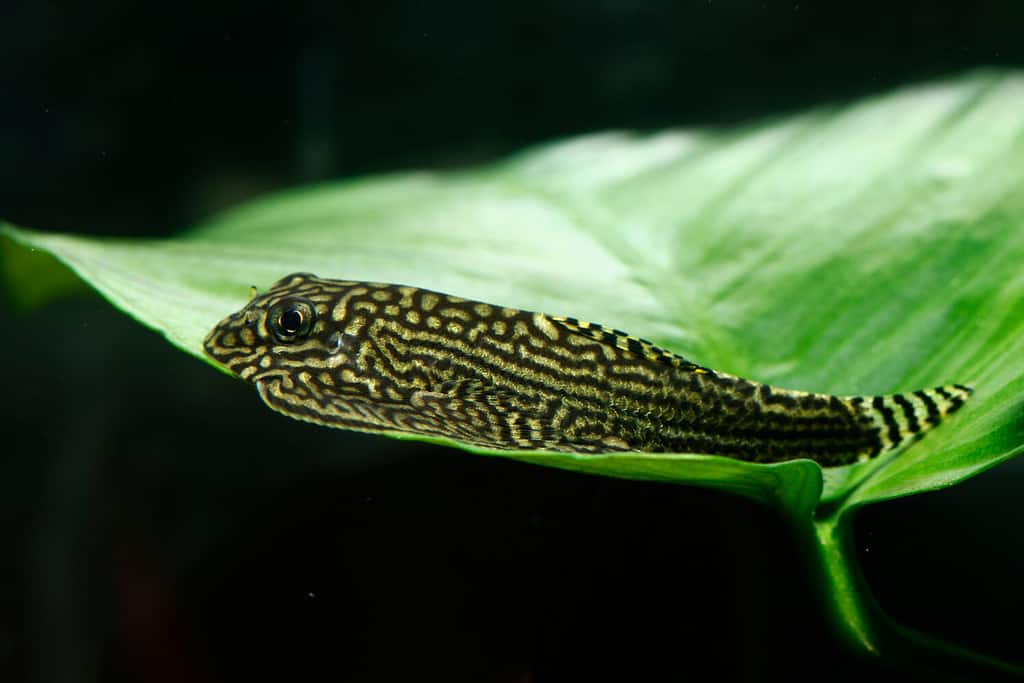
This algae-eating bottom dweller, the hillstream loach, is a great addition to a goldfish tank.
©Pavaphon Supanantananont/Shutterstock.com
The hillstream loach is a harmless, slow-moving, algae-eating bottom dweller. They are primarily found in fast-flowing freshwater streams and rivers in Southeast Asia. These loaches are relatively small, growing to around 2 to 3 inches in size, and they look like smaller stingrays. However, they believe more similarly to a pleco. Hillstream loaches have interesting features and are commonly liked for their olive-brown body covered in intricate, net-like black patterns. A great and unique addition to any home aquarium for sure!
The hillstream loaches make a perfect tank mate for your goldfish, as they also thrive in cooler water temperatures. In fact, the ideal range for their care is typically between 65 to 80 degrees Fahrenheit. They are also peaceful companions that won’t hassle your goldfish and can easily swim away if a curious goldfish gets too close. Moreover, they’re great at munching on algae, so they help to keep your aquarium clean!
2. Dojo Loach (Misgurnus anguillicaudatus)
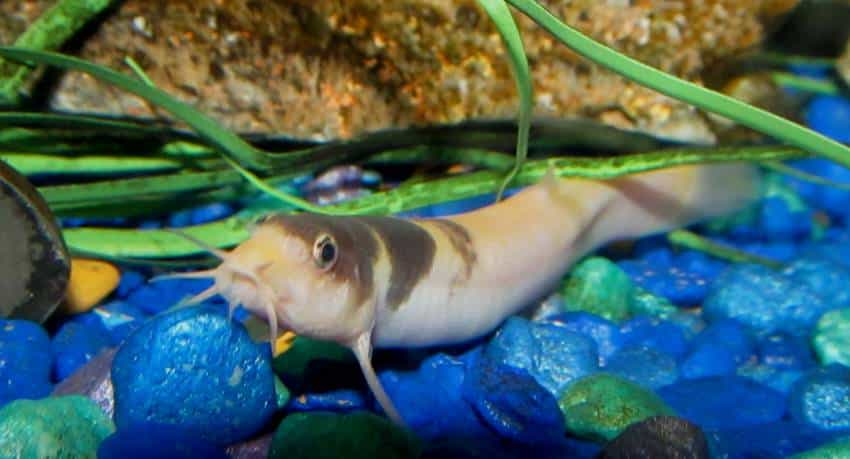
With its sleek body, the dojo loach can grow rather long.
The dojo loach, also known as the weather loach, is a charming fish with a sleek, elongated body covered in subtle, earthy colors like olive and beige. It can be found in various countries, including China, Japan, Korea, and Russia. It’s well adapted to the rivers, ponds, and rice paddies in these regions.
They are ideal for the goldfish as they are a large species, growing to an average of 6 to 12 inches long. They are also bottom-dwelling scavengers, so they are able to help make your tank clean by consuming algae and other particles.
As you may be able to tell from the sheer size of these fishes, these large loaches need enough space to cohabit with your goldfish. So, provide a tank with at least 50 to 55 gallons, which is plenty of space for your goldfish as well. They also prefer a tank with good filtration and a soft substrate, such as little pebbles, for burrowing. They have a similar colder temperature preference similar to the goldfish, which is 50 to 77 degrees Fahrenheit. Dojo loaches are peaceful and social, which can create a harmonious living for the two species. It’s no wonder this fish is the most popular tank mate for a goldfish.
3. Roby Barb (Puntius conchonius)
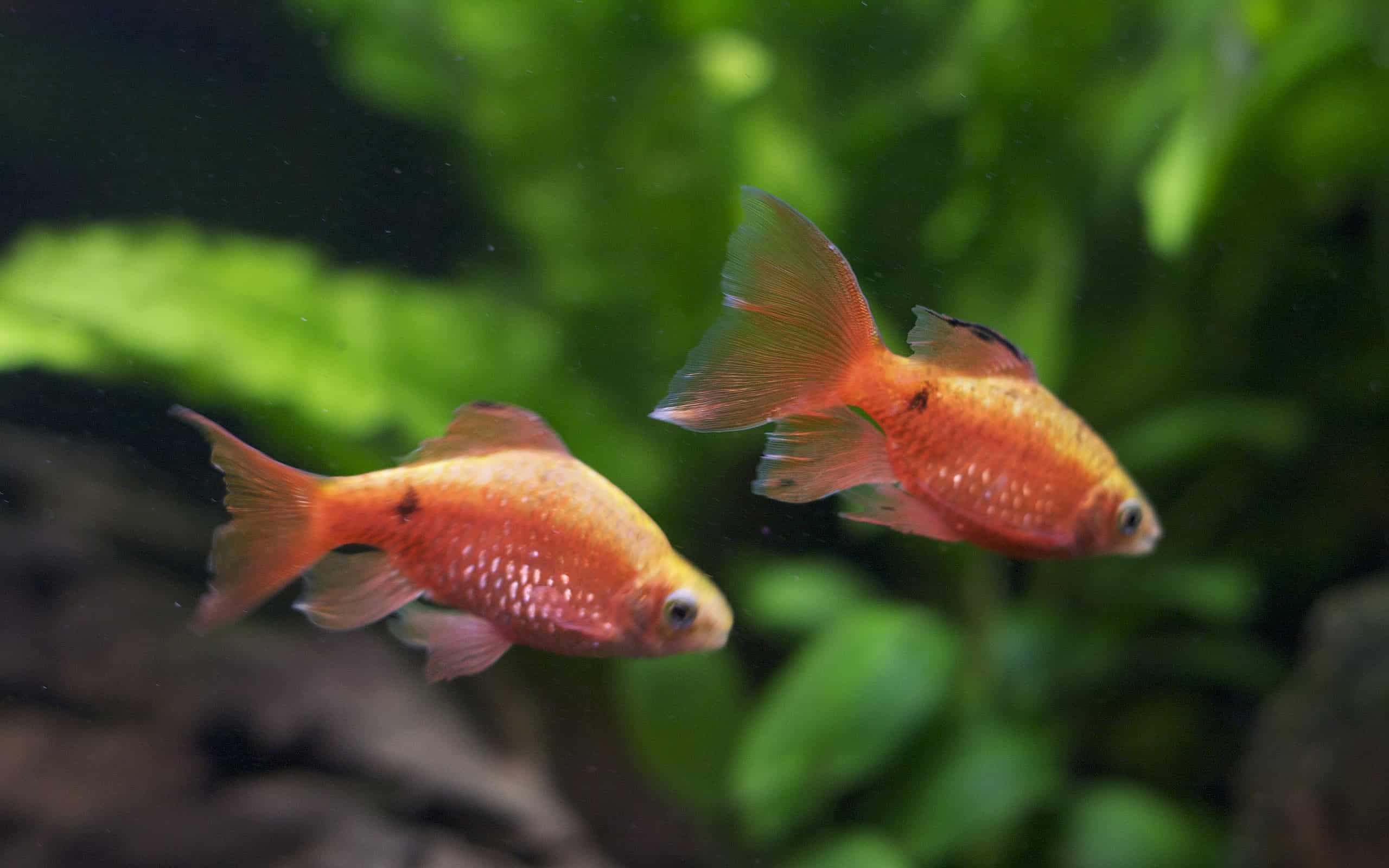
Rosy barbs may exhibit aggressive behavior when alone, so make sure to keep them in small groups.
©Kkonstan, CC BY 3.0, via Wikimedia Commons – Original / License
Among the barb family, rosy barbs rank as one of the larger members as they typically grow to be 4 to 6 inches long. Native to India, rosy barbs are also one of the most famous aquarium fish as they are vibrant with pink, orange, and red colors and are easy-going in nature. When planning to keep them together as tank mates with the goldish, it is best to keep the rosy barbs in a minimum group of 5, as they are social creatures and may exhibit aggressive behaviors when alone. As a community of rosy barbs, they’ll generally keep to themselves and leave your goldfish alone.
Rosy barbs are active swimmers, so providing enough space for them to explore and socialize is essential, and keeping a tank size of 30 gallons is recommended. Both rosy barbs and goldfish prefer similar cooler water temperatures (65 to 78 degrees Fahrenheit), which makes it easier to maintain the tank for both species. They can make great tank mates with the goldfish as both species are peaceful.
4. Bristlenose Pleco (Hypostomus cirrhosus)
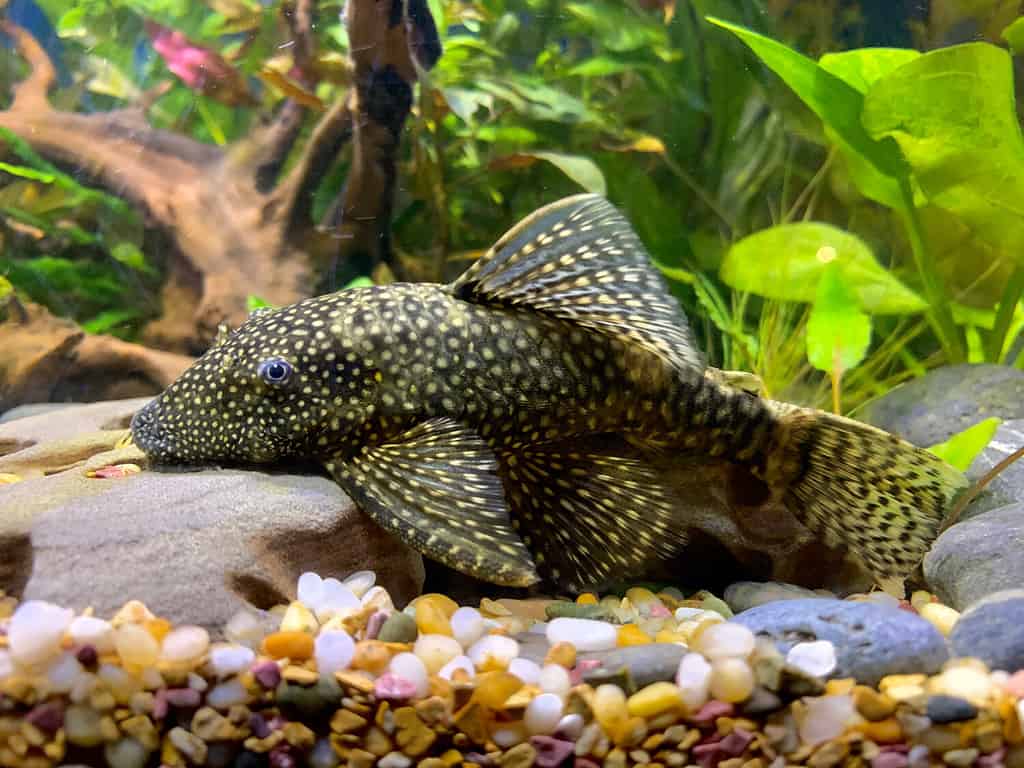
If you’re looking to add a unique look to your goldfish tank, introduce the bristlenose pleco as its tank mate.
©TTONN/Shutterstock.com
The bristlenose pleco is a very unique-looking catfish that originates from South America. Like loaches, they also have an algae-consuming habit that keeps your tank looking fresh. These odd-looking plecos have flattened bodies covered in armor-like plates. They also have “bristles” on their heads, which look like a funky mustache, almost like a catfish.
Bristlenose plecos are peaceful in nature and will tend to shy away from goldfish if needed. Try to provide some hiding places within the tank for a peaceful environment. Interestingly, one study has found that goldfish and plecos can help each other in a way. The goldfish will eat the algae off the pleco’s body and vice versa! However, if you find that the pleco is sucking on your goldfish’s shiny coat, it may mean it hasn’t had enough food. So, definitely keep an eye on that behavior!
Plecos can grow up to around 4 to 6 inches long, which is a great size for the goldfish. Caring for them is relatively easy, as they are easy-going and like to be in hiding spots. In terms of tank size, these bigger species require a minimum of 20-gallon tank with a water temperature of around 72 to 80 degrees Fahrenheit.
5. Rubbernose Pleco (Chaetostoma milesi)

As peaceful fish, rubbernose plecos make great tank mates for goldfish.
©Ictiologia Universidad Católica de Oriente / CC BY 2.0 – Original / License
The rubbernose pleco is another peaceful fish that makes an ideal tank mate for the goldfish. Aquarium hobbyists like to keep them in tanks for their quirky looks and helpful hobby as an enthusiastic aquarium algae cleaner. As their name suggests, they have rubbery-looking lips that protrude from its face. Although similar to the bristlenose pleco in many ways, the rubbernose pleco does not have the signature whiskers. In the wild, these fish are commonly found in the Amazon River basin. Rubbernose plecos can grow to around 4 to 5 inches in size and have a grayish-green hue.
As these fish grow older, plecos have a tendency to become territorial. Therefore, ensuring enough hiding spots made of driftwood and smooth rocks will help keep a peaceful cohabitation between your rubbernose pleco and goldfish. It is important to have a 20-gallon tank or larger to ensure there is adequate space.
Like the bristlenose pleco, rubbernose plecos thrive in similar water temperatures as the goldfish, between 72 to 78 degrees, but they can also tolerate cooler water. Rubbernose plecos make fantastic tank mates for goldfish because they’re peaceful, and their unique appearance adds diversity to your aquarium.
6. White Cloud Mountain Minnow (Tanichthys albonubes)

A gorgeous and brightly-colored fish, the White Cloud Mountain minnow can escape a curious goldfish if need be.
©Besjunior/Shutterstock.com
White Cloud Mountain minnows are small, brightly colored freshwater fish native to China. They are very visually appealing as they have a silver-green body and bright red fin and tail. Being a hardy and highly reproductive species, they are a favorite among beginners who want to start their aquarium hobby.
These minnows typically grow to about 1.5 inches in size and are able to thrive in smaller tanks of around 10 to 20 gallons. They, too, prefer cooler water temperatures ranging from 64 to 77 degrees Fahrenheit. White Cloud Mountain minnows make great tank mates for goldfish due to their peaceful nature and adaptability to similar water conditions. Although they may be small, White Cloud Mountain minnows are generally fast enough to escape a curious or hungry goldfish if need be. And if one does accidentally get eaten, don’t worry; it’s not harmful to your goldfish! To avoid this as much as possible, try growing these fish outside of the goldfish tank until they are large enough to handle the goldfish.
7. Ricefish (Adrianichthyidae)

Looking like white cloud mountain minnows at first glance, the ricefish prefers a slightly cooler water temperature.
©saiglobalnt/Shutterstock.com
The ricefish belong to the family, Adrianichthyidae, of small ray-finned fish found in fresh and brackish waters from countries like India and Japan. They are small and fascinating to watch, as they have iridescent scales that often shimmer with colors like silver, gold, or green. They look relatively similar to white cloud mountain minnows.
These ricefish are also relatively small, growing to around 1-2 inches in size, so a 10-gallon tank works well. They prefer a slightly cooler water temperature, between 61 and 77 degrees Fahrenheit, almost perfect for your goldfish.
Ricefish are peaceful and make ideal tank mates for goldfish because they share similar water temperature preferences and won’t disrupt your goldfish’s peaceful environment. However, keep in mind that this species is definitely not the cheapest on this list, and they may contribute to organic waste in the tank. So, you should ensure your tank is big enough to hold ricefish and goldfish (and any other species, if applicable).
8. Zebra Danio (Danio rerio)
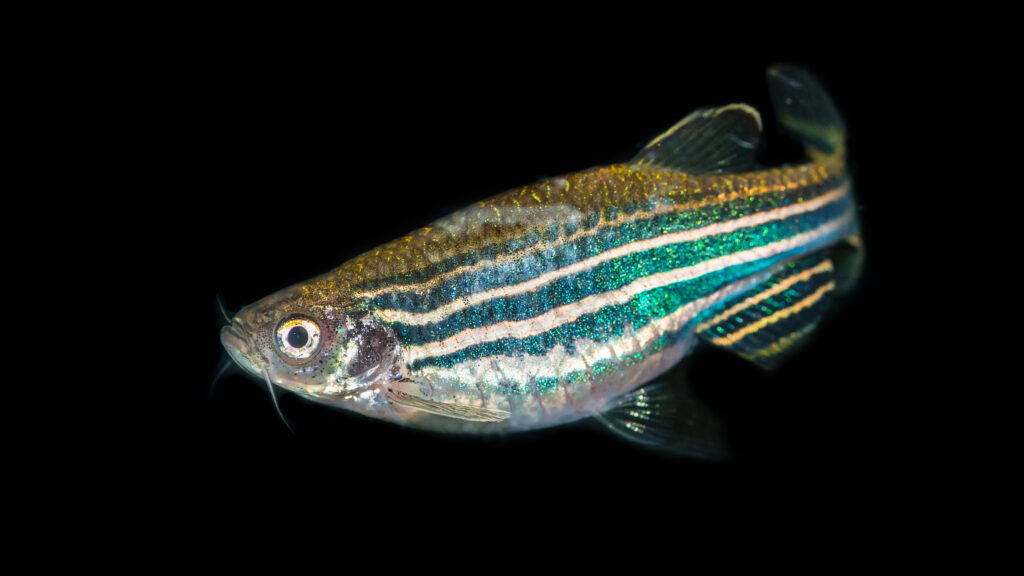
These fish are peaceful in nature and should not bother your goldfish.
©Ian Grainger/Shutterstock.com
The zebra danios have slim bodies with horizontal black and white zebra-like stripes. They originate from tropical and subtropical waters in India, Bhutan, and Bangladesh. Danios are a very popular fish as they are social and peaceful in nature and can be easygoing with many other tank mates, including goldfish.
Though they typically grow to about 2 inches, they require ample tank space as zebra danios are known for their schooling behavior. Keeping them in a group helps reduce stress and aggression, as zebra danios feel safer and more comfortable when they have companions of their own kind. A minimum of 5 is ideal, as you do not want to overcrowd your fish. This schooling behavior comes in handy when keeping zebra danios with your goldfish, too, which is not enticing for the goldfish at all.
The minimum tank size is 10 gallons with an ideal water temperature of 64 to 74 degrees Fahrenheit, but they are adaptable.
9. Hoplo Catfish (Megalechis thoracata)
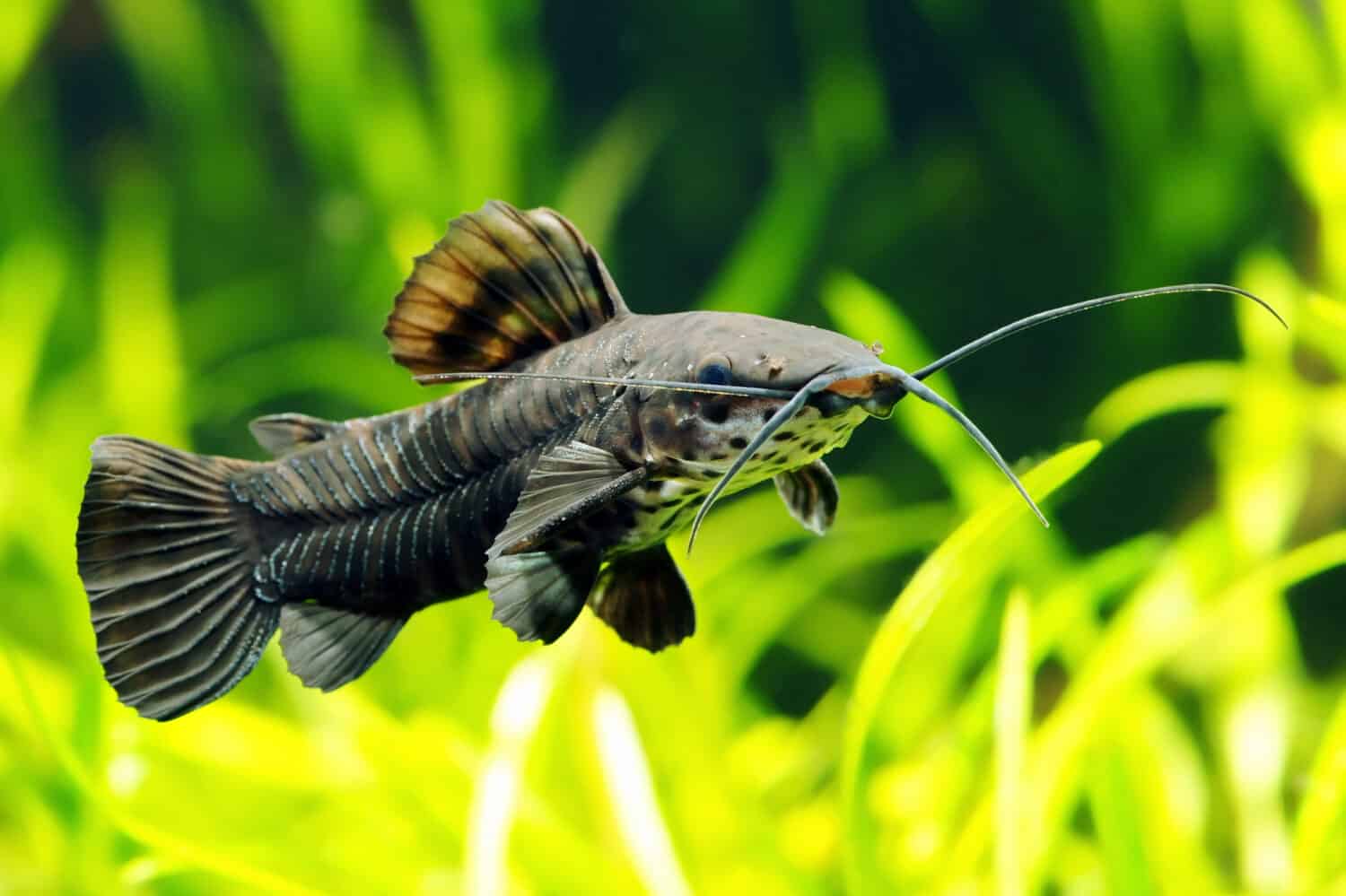
Native to South America, the hoplo catfish is non-aggressive and can adapt to cooler waters.
©2144528/Shutterstock.com
The hoplo catfish is a catfish native to the South American tropics, reaching sizes of 6 to 8 inches. This catfish is one of the most unique-looking fish, as it has an armored appearance. These fish also have flat, rounded bodies covered with bony plates, protecting them from the fin-nipping goldfish and other species.
A suitable tank size for hoplo catfish would be at least 30 gallons or more to provide enough space for their growth and to accommodate their bottom-dwelling behavior. They often sift through substrate and occasionally burrow in the tank.
As peaceful and beneficial fish, these catfish make an ideal tank mate for goldfish. Moreover, hoplo catfish are generally non-aggressive and get along well with other fish in the aquarium. In terms of water temperature preferences, the hoplo catfish prefers 72 to 86 degrees Fahrenheit, but it is adaptable.
10. Variatus Platy (Xiphophorus variatus)

Interestingly, the variatus platy gives birth to live young, which the goldfish may eat for much-needed population control.
©Roberto Dani/Shutterstock.com
The variatus platy is a popular freshwater fish native to Mexico and Central America. They have a sleek and slightly elongated body shape, with a triangular dorsal fin. These platys come in striking colors of yellow, red, orange, and blue, which makes them stand out amongst other fishes in the aquarium. Platies grow to around 2 to 3 inches in size and can do well in 10- to 20-gallon tanks. They also thrive in water temperatures between 68 and 78 degrees Fahrenheit.
Variatus platies can be good tank mates for goldfish because they are peaceful, colorful, and share similar water temperature preferences. Their active swimming and playful behavior can add movement and interest to the tank as well. However, it’s important to ensure that the goldfish are not too large and won’t view the platies as potential prey, as goldfish have a natural tendency to eat smaller fish. But this can be an advantage as variatus platys give birth to live young, and the goldfish can happily help maintain the populations.
Summary of Ideal Tank Mates to Pair With Goldfish
| Number | Tank Mate | Scientific Name |
|---|---|---|
| 1. | Hillstream Loach | Sewellia lineolata |
| 2. | Dojo Loach | Misgurnus anguillicaudatus |
| 3. | Roby Barb | Puntius conchonius |
| 4. | Bristlenose Pleco | Hypostomus cirrhosus |
| 5. | Rubbernose Pleco | Chaetostoma milesi |
| 6. | White Cloud Mountain Minnow | Tanichthys albonubes |
| 7. | Ricefish | Adrianichthyidae |
| 8. | Zebra Danio | Danio rerio |
| 9. | Hoplo Catfish | Megalechis thoracata |
| 10. | Variatus Platy | Xiphophorus variatus |
The photo featured at the top of this post is © Sad Agus/Shutterstock.com
Thank you for reading! Have some feedback for us? Contact the AZ Animals editorial team.







